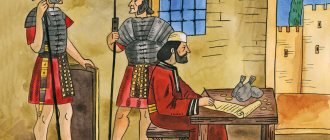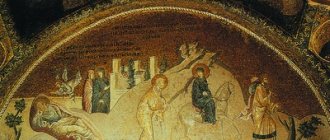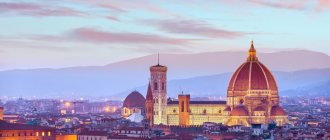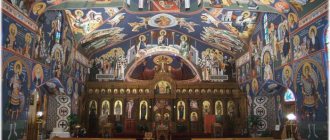On Christmas Eve, Christians remember the gospel story about the worship of the newborn Christ by the Magi, who were led to Him by a miraculous star over Bethlehem. The Magi presented gifts - gold, incense and myrrh. Particles of the Gifts of the Magi are one of the few relics associated with the earthly life of the Savior and preserved to this day.
How do Orthodox Christians celebrate Christmas? More details
Who are the Magi?
In the Gospel, the word “magi” means astrologers and wise men. Watching the heavenly bodies, they saw a hitherto unknown phenomenon and, knowing about the ancient prophecy, went to Bethlehem to see the born King of Glory. The evangelists themselves did not mention the number and names of the Magi - the story of three (according to the number of gifts) Magi (in the West - kings) appeared in early Christian literature and was supplemented in the Middle Ages. According to tradition, the Magi are depicted as people of three ages (Balthasar - a youth, Melchior - a mature man, Caspar - a gray-haired old man) and three cardinal directions (Balthasar - an African, Melchior - a European, Caspar - a representative of Asia). According to legend, the Magi were later baptized by the Apostle Thomas and suffered martyrdom in eastern countries. And their relics were found by Empress Helena of Constantinople and placed first in Constantinople, and then transferred to Western Europe, where they are now kept in the Cologne Cathedral.
Holy Scripture and Church Tradition
Let's first clarify the complexities of translation. If we look at the original Gospels, written in Greek, then the magov, “magi” mentioned in Matthew, are wise men, astrologers, dream interpreters, and priests. The Hebrew translation is more severe: these are sorcerers, fortune-tellers. Both Greek and Jewish interpretations agree on one thing: the people who came to worship the Child were no strangers to magic and astrology. That’s why they were guided by the star that appeared in the east. The Gospel does not mention either the exact number of the delegation or their names. All this information relates to Church Tradition, and therefore can be questioned. But Simon’s sorcery mageu/w is also translated as “witchcraft”, “enchantment”, “casting spells”. Do you feel the difference: sages and sorcerers? Let's figure out what exactly the Tradition of the Church brought into the history of the worship of the Magi.
What did the Gifts of the Magi look like and what did they symbolize?
The Magi brought three gifts to the Baby: gold, incense and myrrh (myrrh). Each of the gifts had its own symbolic meaning:
Reference
Smyrna - (Greek smyrna, myrrha dew incense, incense). Incense resin from a tree native to Arabia and Ethiopia.
gold is a gift to the Child as a king, indicating that Jesus was born to be a King; incense is a gift to Him as God; myrrh, fragrant resin - a symbol of the sacrifice of Christ, a gift to the one who must die.
Article on the topic
How do Orthodox Christians celebrate Christmas Eve? It was these gifts that laid the foundation for the tradition that arose in the Christian world of giving gifts at Christmas and in general to newborns.
According to legend, the Most Holy Theotokos gave the Gifts of the Magi to the Christian community of Jerusalem, after which they were transferred to Constantinople to the Church of Hagia Sophia. After the conquest of Constantinople by the Turks in the 15th century, the daughter of the Serbian prince Maria Branković transported the Gifts of the Magi to Athos, where they have been kept for more than 500 years in the Athos Monastery of St. Paul.
The relic consists of 28 triangular and square gold plates, attached to them on a silver thread are 60 beads consisting of a mixture of frankincense and myrrh.
Today, parts of the relic are stored in ten special arks.
Matthew's story
The evangelist is quite stingy with information. “Wise men from the East” came to Herod and asked: “Where is the king of the Jews, since we saw His star?” Hearing about a possible competitor, Herod became excited. He gathered a council of scribes and folk sages who knew the Torah so that they could point him to the exact place of birth of the Child. They, having studied the books and prophets, pointed to Bethlehem. The Magi went there. They followed the star and found the Baby in the manger and his Mother. They bowed to them and brought frankincense, gold and myrrh to Jesus Christ, the Son of God, who came into this world. Having been admonished by an angel in a dream, they did not return to Herod, but went to their lands by another route. That's it, end of story. Why are these characters mentioned only in Matthew, and nowhere else? Biblical scholars claim that the message of this Gospel is directed to the Jewish population of the Roman Empire. It most often mentions the Prophets, and the entire first chapter is devoted to the genealogy of Jesus, although all Christians know that He is the son of the living God, and has nothing to do with Joseph from the line of David. In Matthew, the “eastern wise men” are experts in the Jewish Scriptures who calculated by the movement of the stars when the Messiah would come to earth.
Modern Neopagans
At the turn of the 20th-21st centuries, after the discredit of the Orthodox Church, many people appeared in our country who considered themselves neo-pagans. These magicians of Russia are actively engaged in preaching and publishing activities. They are the religious authorities and priests of their communities of believers. At the same time, on the pages of magazines and newspapers you can read many advertisements about healers and magicians who drain wax, remove the crown of celibacy, and the like. The Russian Orthodox Church considers the activities of both to be displeasing to God, since all divination and magic are warlocks. But let's be lenient. If we analyze historical sources, and also take into account the opinion of art historians, then the holy gifts of the ancient Magi, carefully preserved by the monks on Mount Athos, are nothing more than fiction. Why?
Written evidence does not mention the gifts of the Magi as relics until the eleventh century. Around 1200, Archbishop Anthony of Novgorod visits Constantinople and writes that Hagia Sophia contains golden vessels, which “the sorcerers brought to the Lord with gifts.” The first mention of the current form of gold - as we remember, gold plates - dates back only to the fifteenth century. Having studied the ornament and filigree technique on them, art historians came to the conclusion that they once formed one piece of jewelry - a belt decorated with post-Byzantine filigree. The jewelry was made in the 15th century.
Frankincense, gold, myrrh
Adoration of the Magi.
Gentile da Fabriano, 1423 Actually, Christians revere the Three Magi precisely because they were the first among people who did not belong to God’s chosen people of Israel to come to worship Christ and recognize Him as the Messiah. They brought very symbolic gifts to the Savior. Gold was presented to Him as the King of kings. On the one hand, it is a symbol of the tribute that subjects bring to their ruler. On the other hand, gold has always been used to make the most luxurious things, and often used to decorate sacred relics. The cherubim on the Ark of the Covenant in the Jerusalem Temple were golden, the faces of saints on icons are decorated with golden halos, temples are often crowned with golden domes... In addition, gold is also a symbol of wisdom (“golden words”, “silence is golden”) and eternity (due to that this metal does not deteriorate over time). All these properties and meanings give a very deep understanding of why gold was brought as a gift to Christ. After all, the King of kings is the wisest and most glorious, the One who has power and always uses it for good. Frankincense, an expensive aromatic resin, was offered to Christ as God and High Priest. This incense is traditionally used for incense performed by a clergyman. This symbolically expresses a person’s reverence for God. In addition, incense reminds us that everywhere in the world, in everything, the Holy Spirit dwells, the third hypostasis of God the Trinity. As for the rank of the High Priest... The Old Testament king David called Christ Hierean after the rank of Melchizedek, the ancient king, who was also a priest. Little is known about this man. But in the Book of Genesis one very symbolic episode is associated with it. When Abraham came to Melchizedek, he greeted the guest in a special way - he brought him bread and wine, that is, a prototype of the Eucharistic sacrifice of the New Testament. Therefore, Christ, who established the Sacrament of the Eucharist, whose Body and Blood in the form of bread and wine is received by Christians during communion, is called the High Priest, with reference to Melchizedek. The Magi gave myrrh, a funeral incense, to Christ as the One who must die for people. Perhaps they knew from prophecies what the fate of the Messiah would be, that He would endure persecution and suffering, go to the cross and give His life to save people from death. And His death will be followed by the Resurrection - that is why He came and why He was so expected.
Lost in translation
The Synodal presentation of the New Testament has brought confusion into the consciousness of ordinary Orthodox Christians. Simon, mentioned in “Acts,” is a negative character who wants to purchase the Holy Spirit with money in order to perform greater miracles than he previously performed through sorcery. Why then should we honor the magicians who came to worship in Bethlehem? The very word “vulkhv” in the Old Slavonic dialect means wizard, sorcerer, sorcerer. We will not go into the etymology of this term now. Whether it comes from the word “hair” or “vlesneti” (to speak vaguely, to mutter) is not important. Let's take a better look at who the Magi of Ancient Rus' were.
Not only in our lands, but also in other lands, pagan religions revered “knowing people.” They were knowledgeable in herbs, black and white magic, astrology, and knew how to predict the future. This was a special caste of priests who were engaged in conducting religious rites, fortune-telling, prophecies, as well as preparing potions and treating the sick. We can say that among the Celtic tribes the Magi were called Druids. Representatives of this unique spiritual caste occupied a fairly high position and enjoyed great authority among the people. Great princes came for their advice, as well as prophecies (let’s remember the Prophetic Oleg or Gostomysl). What can I say! Some princes from the Polovtsian dynasty also possessed the gift of magic. Bryachislav Izyaslavovich defended the pagan priests from the persecution of Yaroslav the Wise. And his son - Vseslav Bryacheslavovich Polotsk - was born from sorcery. All his life he wore the “veil” in which he was born as a talisman. If you believe “The Tale of Igor’s Campaign,” Vseslav was a werewolf, mastered the techniques of obsession and knew how to tell fortunes.
With the adoption of Christianity by Prince Vladimir, the Slavic Magi began to be subjected to repression. Prince Yaroslav the Wise of Kiev was especially zealous. Around 1010 he destroyed the temple of Veles. In its place, the prince built the city of Yaroslavl. Gleb Novgorodsky and Jan Vyshatich also took up arms against the Magi. Doctor of Historical Sciences I. Ya. Froyanov believes that in this struggle one can see the confrontation between the old pagan beliefs of the Slavic people and the new religion. After all, Christianity was “descended from above”, imposed by secular authorities. Written sources mention sorcerers up to the thirteenth and fourteenth centuries, in particular in Pskov and Novgorod. But gradually the meaning of the word “magician” is transformed. During the days of unrest, churchmen called religious dissidents and heretics this way, attributing to them practicing magic, communicating with demons, causing crop failure and loss of livestock. In times of peace, folk healers and healers were called Magi.
Journey of Relics
The remains of the saints did not remain in Constantinople for long. Already in the 5th century they were worshiped in Mediolan, the capital of the Duchy of Lombardy (modern Milan in Italy). In the twelfth century, Holy Roman Emperor Frederick Barbarossa conquered this territory and took the relics to Germany. Written evidence has been preserved that the relics were presented to the Archbishop of Cologne, Rainald von Dassel, who in 1164 took them out of Italy, first on carts, and then on a ship along the Rhine. It is said that the construction of the tallest Gothic cathedral was initiated by the desire to create a majestic “ark” for the incorruptible remains of the three kings. And now the relics of the Magi rest in the reliquary, which was created by the skilled craftsman Nikolai of Verdun, in the altar part of the Cologne Cathedral.
But what did Marco Polo see then, when he visited Sawa, a city located south of Tehran, at the end of the thirteenth century? In his notes, the traveler reports that he visited three nearby and beautifully decorated tombs of the Magi. The bodies exhibited there were not at all affected by decomposition. Marco Polo especially emphasized this circumstance: “Like recently dead people, with beards and hair.” Unfortunately, these relics from Sava were lost without a trace. But in Cologne, only bones are kept. They are shown to the crowd only from afar during the celebration of the Three Kings Day (January 6th).










